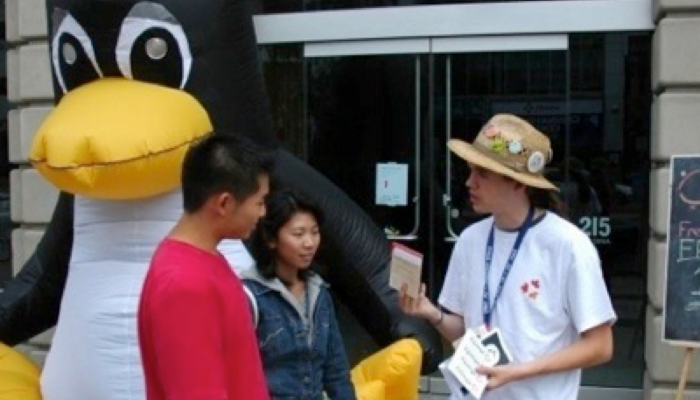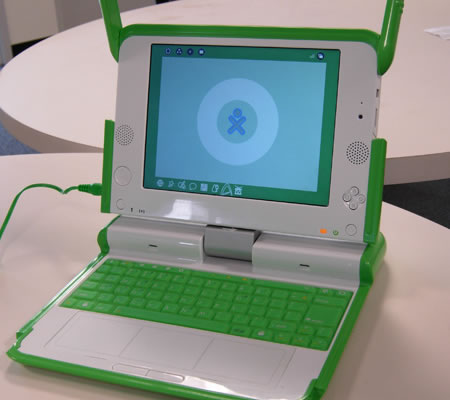Ontario Linux Fest

Yesterday, I teamed up with and old friend of mine (Scott Elliott) and went to the Ontario Linux Fest at the Toronto Congress Centre. For those who do not know Scott, he is a VMWare guru (you can join his Southwestern Ontario VMWare user’s group @ www.vmware.com), as well as a master in the 8th layer of the OSI Model (the political layer). Although he won’t admit it, he knows UNIX very well and is an advocate of the Open Source movement even though he works mainly with Windows.
There were 2 booths that had a Playstation 3 running Linux - one of them ran YellowDog Linux and had a 3D rendering demo of a car and all of its components that showed how each of the six sub-cores of the Playstation’s PPC Cell processor worked together to render each component in turn - each area was highlighted differently to indicate the cores so you could “see” it happen - very very cool.
There was also some free BSD swag and FSF/GNU stickers (not nearly as much as I expected from the misleading “swag package” that was mentioned in the conference emails leading up to the conference). The networking was probably my favorite part of the conference.  I recognized several people (some new some old), received some software, and got to play with someone’s iPod with the multi-touch screen (basically an iPhone) that was hacked to include all kinds of other programs you need to be productive. They also had a very tiny 10Watt PC with a 2.5-inch hard drive and 512MB of RAM called Koolu running Ubuntu very fast (http://www.koolu.com). Scott also got some good info on a somewhat boring (from my irrational perspective) Linux management system that he will probably buy for his company.
I recognized several people (some new some old), received some software, and got to play with someone’s iPod with the multi-touch screen (basically an iPhone) that was hacked to include all kinds of other programs you need to be productive. They also had a very tiny 10Watt PC with a 2.5-inch hard drive and 512MB of RAM called Koolu running Ubuntu very fast (http://www.koolu.com). Scott also got some good info on a somewhat boring (from my irrational perspective) Linux management system that he will probably buy for his company.

Also, with all the hype about the One Laptop Per Child (OLPC) project, I wanted to see the thing up close. I got my wish - they had one at one of the vendor booths later on in the show that people were playing with. It was much much smaller than I expected - the screen was tiny (only 7 inches!), which is not enough to browse most webpages properly. The buttons were tiny and resembled those on a Wii controller - I could never press those keys without hitting 3 at a time by accident! Overall it resembled a Fischer-Price toy. The picture to the right makes it look like a smallish laptop, but in real life, it is tiny - not something I would pay $400 for :-)
Although some of the sessions looked good (Xen, OLTP, Linux Advocacy, Eclipse) compared to others (Yoga for Geeks), we actually only attended one session. That one session was “Xen virtualization on SUSE Linux” (like VMWare), and it was terrible because the presenter gave no depth, seemed like an asshole overall, didn’t know how to work a projector, and refused to select me during the question period because he knew that Scott was an expert in his subject and it that it was probably a tough question. He was right, because my question (actually Scott’s question) was “How do you see KVM affecting Xen?” (KVM is a new Open Source development that is supposed to replace Xen and make it obsolete - which would make him look bad :-)
On the flip side, the keynote from Ted Tso was fantastic. It was both informative and funny (he kept messing up). He encouraged Open Source developers to join EFF to fight copyright globalization, patent trolls and the DMCA, as well as addressed key issues such as the new GPLv3. Ted also pointed out that most Linux development today was more engineering (bug fixes, incremental updates, GUI front-ends) rather than R&D (kernel development) and documentation. He also noted that, although engineering of existing technologies generates money quickly, we may run into problems in the future if Linux developers are not developing new ideas (good point).
Ted Tso also addressed the most important topic of all: our relationship to proprietary software. He discouraged hostility to proprietary software because there will always be some software that must be proprietary because there is not enough Open Source effort to make those products (e.g. Tax Software). He urged everyone to promote proprietary software development on Linux - this will draw users away from Microsoft, and encourage many of these proprietary software programs to eventually become Open Source.
However, to encourage the adoption of Linux and the replacement of some proprietary software with Open Source equivalents, Ted mentioned that Linux needs bling, lots of software, and ease of use. Linux already has plenty of bling (Beryl), as well as loads of software (he recommended that we replace MS Office with OpenOffice, which I don’t agree with). However, he mentioned that the ease of use needs to go further and match that of Mac OS X.
The second keynote from Jon “Maddog” Hall was extremely boring and at the end they drew for prizes and did the closing ceremony (which was somewhat disorganized and dull).
I decided not to bring my Macintosh laptop because I thought that a Linux conference would not approve of a partly proprietary OS like Mac OS X. Ironically, there were about 4 times as many Macs at the conference compared to PCs! Anyways, I have another laptop with Windows Vista installed for stuff I had to do for my school, so I quickly installed Fedora Linux on it as a dual boot, installed the video driver and compiled the NDIS wrapper driver for my wireless card. However, when I tried to get Internet at the conference, my NDIS wrapper didn’t load into the kernel - in my haste, I chose the wrong driver file for my wireless card the night before when I installed Fedora! Damn. So, our only option was to reboot into Vista (at a Linux conference!) and download the right wireless card driver. At this time, there were sessions going on, so we searched for an outlet in the hallways, but the only spot was a narrow table along the wall where anyone passing by would see my laptop screen and Vista. Luckily I had a Linux background theme on my Vista install, but it was quite comical while we were trying to get Vista connected to the wireless network at the convention centre - they had about 10 wireless network names and the password we were given didn’t work on the ones we tried. Time was running out - anyone could walk by and see us running Vista. And to make matters worse, Scott was going through major withdrawal because he left his Crackberry in the car and was worried he would get a call from his boss (wife). So the pressure forced us to boot from a live Fedora Core 7 CD to see if it had the driver (live CDs usually have them). While Fedora Core 7 was loading from RAM, the init daemon kept getting interrupted so I had to press the power button to interrupt it and continue onto the next daemon for each daemon that was loaded (ahhhhhhhghhh!). To make a long story short, we gave up and I made a mental note to ALWAYS TEST MY NDIS WRAPPER BEFORE TAKING THIS STUPID LAPTOP TO A LINUX CONFERENCE.
Oh yes, and when we left the conference, there was a car we passed that had a window smashed in (which is why you should never leave expensive stuff in your back seat such as laptops). The license plate on the car had the word Linux in it, so we joked that it was another victim of a Microsoft evangelist.
Overall, I think the day was worth the time - although it seemed more like a LUG (Linux Users Group) meeting than a conference, I got some good stickers (I am fond of stickers), played with some cool stuff, and got some good information. Plus, when Scott and I got back to Cambridge, we had the typical nerdy 6 hour conversation about software, virtualization and Open Source philosophy. It was a pretty good day.